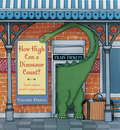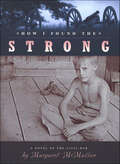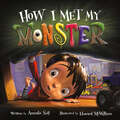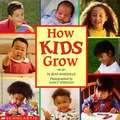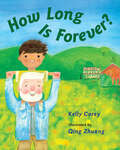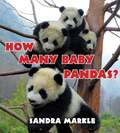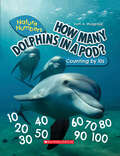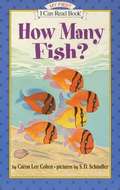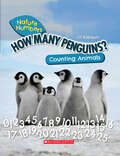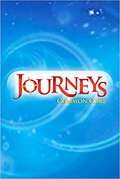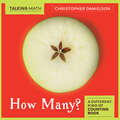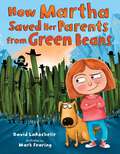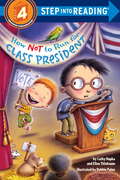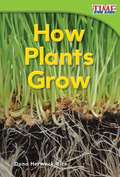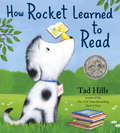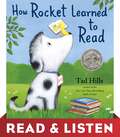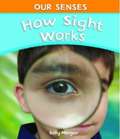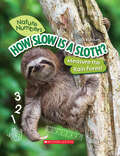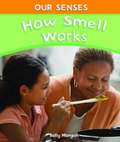- Table View
- List View
How High Can a Dinosaur Count?: ...and Other Math Mysteries
by Valorie FisherBelieve it or not, once Bessie balanced a tower of 8 beets. But today, when she tries to balance 8 beets . . . 3 fall. How many beets does Bessie balance today?A clever text and imaginative art mesh to create playful, simple math problems right on target for ages 5-99 . . . anyone who loves the magic of numbers! In this School Library Journal Best Book of the Year, budding young mathematicians can help Heloise add her dimes, nickels, and pennies to see which hat in Madame Millie's Hat Shop she can buy. Or they can tell time with Lulu at the Tutti-Frutti Zoo, where Lollipop Licking begins at 9:00 sharp.From the Hardcover edition.
How I Found the Strong
by Margaret McMullanIt is the spring of 1861, and the serenity of Smith County, Mississippi, has been shattered by Abraham Lincoln’s declaration of war on the South. Young and old are taking up arms and marching off to war. But not ten-year-old Frank Russell. Although he is eager to enlist in the Confederate army, he is not allowed. He is too young, too skinny, too weak. After all, he’s just “Shanks,” the baby of the Russell family. War has a way of taking things away from a person, mercilessly. And this war takes from Frank a mighty sum. It’s nabbed his Pa and older brother. It’s stolen his grandfather, his grandmother. It has robbed Frank of a simpler way of life, food, his boyhood. And gone are his idealistic dreams of heroic battles and hard-fought victories. Now all that replaces those images are questions: Will I ever see my father and brother again? Why are we fighting this war? Are we fighting for the wrong reasons? Will things ever be the same around here?
How I Met My Monster (I Need My Monster)
by Amanda NollOne night, when Ethan reaches under his bed for a toy truck, he finds this note instead: "Monsters! Meet here for final test." Ethan is sure his parents are trying to trick him into staying under the covers, until he sees five colorful sets of eyes blinking at him from beneath the bed. Soon, a colorful parade of quirky, squeaky little monsters compete to become Ethan's monster. But only the little green monster, Gabe, has the perfect blend of stomach-rumbling and snorting needed to get Ethan into bed and keep him there so he falls asleep—which as everyone knows, is the real reason for monsters under beds. With its perfect balance of giggles and shivers, this silly-spooky prequel to the award-winning I Need My Monster and Hey, That's MY Monster! will keep young readers entertained.
How Is a Crayon Made?
by Oz CharlesEver wonder how crayons are made? Find out about all the steps that go into making your favorite crayons in this book!
How Kids Grow
by Jean MarzolloFrom seeing and tasting to buttoning a shirt or losing a tooth, the special moments in a child's life are captured in Jean Marzollo's straightforward text. Photographer Nancy Sheehan's clear, bright images of multicultural children -- from a three-day-old infant to a cartwheeling seven-year-old -- are sure to enchant readers of all ages.
How Long Is Forever?
by Kelly CareyFans of Guess How Much I Love You will love figuring out how long forever is alongside Mason and Grandpa.Mason is waiting for Nana's blueberry pie and complains that it's taking forever. So Grandpa challenges him to figure out how long forever really is. Is it as long as Grandpa has had his tractor? No. As long as it took Nana to grow the roses to the top of the chimney? Not even close. After a trip around the farm to figure out the answer, Nana's pie is ready. And Mason's finally got the answer: forever is how long he'll love Nana's pie and how long he'll love Nana and Grandpa, too.
How Long Is a Month? (The\calendar Ser.)
by Claire ClarkA lot happens in a month! As the moon makes one trip around Earth, plants grow and you do too. Find out more in How Long Is a Month?
How Many Baby Pandas?
by Sandra MarkleBaby pandas abound as readers learn how they live and grow. Science expert Sandra Markle bumps up the cuteness factor in this adorable photo essay featuring the eight panda pairs that were born during a baby boom at China's Wolong Giant Panda Breeding and Research Center in 2005. Basic counting skills combine with panda facts to introduce readers to numbers and these cuddly cubs, from the moment they were born to the time they started climbing trees. Tracked as they play and grow in captivity, until they are strong enough to be released into the wild, these baby pandas will steal any reader's heart, whether it's one at a time or sixteen at once!
How Many Dolphins In a Pod?: Counting By 10's (Nature Numbers)
by Ruth MusgraveIn Nature Numbers, math is beautiful, recognizable, and all around us! Highly engaging pictures of animals and nature scenes, along with cool chalk illustrations, are used to introduce basic math concepts and encourage kids to see a world of numbers all around them.K-2 math concepts include power of 10. This book encourages kids to learn about multiples of 10 as schools of fish swim by and coral polyps build reefs, all with amazing nature pictures and chalk illustrations!
How Many Fish? (I Can Read! #My First Shared Reading)
by Caron Lee CohenA story of six fish and six feet interact underneath the water. When one fish gets lost under a bucket, the feet unknowingly saves the fish.
How Many Penguins?: Counting Animals 0-100 (Nature Numbers)
by Jill EsbaumIn Nature Numbers, math is beautiful, recognizable, and all around us! Highly engaging pictures of animals and nature scenes, along with cool chalk illustrations, are used to introduce basic math concepts and encourage kids to see a world of numbers all around them.K-2 math concepts include counting 1-100. This book encourages kids to count groups of 10 animals with amazing nature pictures and chalk illustrations!
How Many Stars in the Sky? (Journeys)
by Lenny Hort James E. RansomeNIMAC-sourced textbook <P><P>Lexile Measure: AD500L
How Many? (Talking Math Ser.)
by Christopher DanielsonTalking math with your child is fun and easy with this better approach to counting!Written by a math educator, this innovative book encourages critical thinking and sparks memorable mathematical conversations. You and your child decide what to count on each page. You have many choices, and the longer you look, the more possibilities you'll notice. There are no wrong answers in this book. As long as you're talking about what you see, think, and wonder, you're talking math!
How Martha Saved Her Parents from Green Beans
by David LaRochelleMartha HATES green beans. When some mean, green bandits stroll into town, anyone who ever said "Eat your green beans" is in big trouble. But when the beans kidnap Martha's parents, Martha is forced to take action. She can think of only one way to stop the villainous veggies from taking over her town, and it&’s not pretty...or tasty. Featuring absurdly funny text and illustrations with attitude, this is a hilarious read for everyone – even the pickiest of eaters.
How Mountains Are Made (Let's-Read-and-Find-Out Science 2)
by Kathleen Weidner ZoehfeldRead and find out about how mountains are made in this colorfully illustrated nonfiction picture book.A mountain might be thousands of feet high, but it can still grow taller or shorter each year. This classic picture book explores how mountains are made—including how Mount Everest grew from a flat plain under an ocean to become 29,028 feet tall.How Mountains Are Made features simple activities and fascinating cross-sections of the earth’s moving crust that clearly explain plate tectonics. Both text and artwork were vetted for accuracy by an expert in the field.This is a clear and appealing science book for early elementary age kids, both at home and in the classroom. It's a Level 2 Let's-Read-and-Find-Out, which means the book explores more challenging concepts for children in the primary grades. The 100+ titles in this leading nonfiction series are:hands-on and visualacclaimed and trustedgreat for classroomsTop 10 reasons to love LRFOs:Entertain and educate at the same timeHave appealing, child-centered topicsDevelopmentally appropriate for emerging readersFocused; answering questions instead of using survey approachEmploy engaging picture book quality illustrationsUse simple charts and graphics to improve visual literacy skillsFeature hands-on activities to engage young scientistsMeet national science education standardsWritten/illustrated by award-winning authors/illustrators & vetted by an expert in the fieldOver 130 titles in print, meeting a wide range of kids' scientific interestsBooks in this series support the Common Core Learning Standards, Next Generation Science Standards, and the Science, Technology, Engineering, and Math (STEM) standards. Let's-Read-and-Find-Out is the winner of the American Association for the Advancement of Science/Subaru Science Books & Films Prize for Outstanding Science Series.
How Not to Run for Class President
by Debbie Palen Ellen Vandenberg Catherine A. HapkaLooking for a fun, light introduction to the campaign process? Join the brothers from the How Not to . . . series as they navigate a class election! Third grader Will couldn't care less about boring school politics. But when his friend Chelsea proposes a Reading Buddy program that would require Will to hang out with the kindergartners (and therefore his little brother, Steve), he makes an impulsive decision to run against her! Supportive brother that he is, Steve takes full responsibility for managing his brother's campaign . . . and things quickly spiral out of control. This fun reader gently teaches what it means to be a responsible politician, and even gets some election basics into the mix. A hilarious tool to kick off classroom units on elections! Step 4 Readers use challenging vocabulary and short paragraphs to tell exciting stories. These books are for newly independent readers who read simple sentences with confidence.From the Trade Paperback edition.
How People Learned to Fly
by Fran HodgkinsIn this book you find out about the many obstacles that have been overcome so planes and people can soar through the sky. <P><P>[This text is listed as an example that meets Common Core Standards in English language arts for K-1 at http://www.corestandards.org.]
How Plants Grow (Time For Kids®: Informational Text)
by Dona Herweck RiceBeginning readers explore the steps to make plants grow! Readers will learn about various parts of the plant including seeds, roots, and leaves in this engaging nonfiction title. Featuring vivid, clear photos and simple, informational text, even the most reluctant reader will be captivated!
How Rocket Learned to Read (Rocket)
by Tad HillsThis sweet picture book starring an irresistible dog named Rocket and his teacher, a little yellow bird, is perfect for back-to-school! Follow along as Rocket masters the alphabet, sounds out words, and finally . . . learns to read all on his own. With a story that makes reading fun-and will even help listeners learn to read-this book is ideal for kindergarten classrooms and story hour or as a gift for that beginning reader. Fresh, charming art by Tad Hills, theNew York Timesbestselling author/illu...
How Rocket Learned to Read: Read & Listen Edition (Rocket)
by Tad HillsLearn to read with this Read & Listen edition of the New York Times bestselling picture book, starring an irresistible dog named Rocket and his teacher, a little yellow bird. Follow along as Rocket masters the alphabet, sounds out words, and finally . . . learns to read all on his own!With a story that makes reading fun—and will even help listeners learn to read—this book is ideal for kindergarten classrooms and story hour or as a gift for that beginning reader. Fresh, charming art by Tad Hills, the New York Times bestselling author-illustrator of Duck & Goose, will make this a favorite.This ebook includes Read & Listen audio narration.
How Sight Works (Our Senses)
by Sally MorganThis book introduces the sense of sight and how it helps us function in everyday life.
How Slow Is a Sloth?: Measure the Rainforest (Nature Numbers)
by Jill EsbaumIn Nature Numbers, math is beautiful, recognizable, and all around us! Highly engaging pictures of animals and nature scenes, along with cool chalk illustrations, are used to introduce basic math concepts and encourage kids to see a world of numbers all around them.K-2 math concepts include measuring. This book explores measuring elements of the rainforest with amazing nature pictures and chalk illustrations!
How Smell Works (Our Senses)
by Sally MorganWhy do some things smell good and other things smell bad? This book explains where our sense of smell comes from and how it helps us function in everyday life. A lively, straightforward narrative presents scientific concepts for young readers and an activity is included enhance the learning experience.
